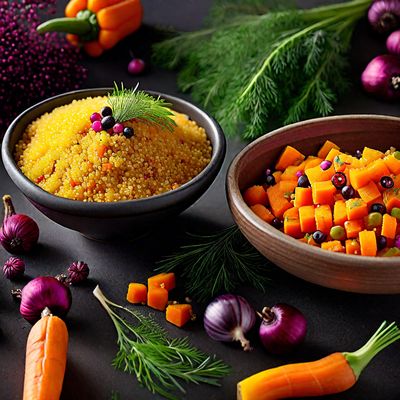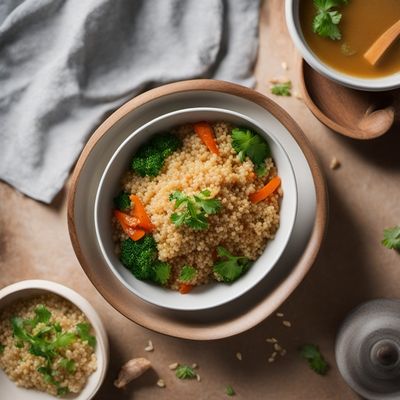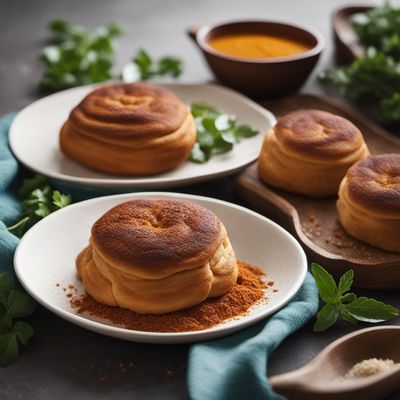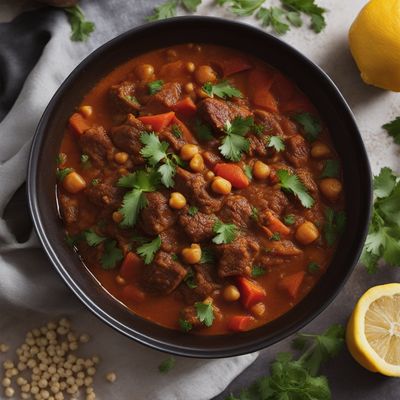
Recipe
Molecular Gastronomy Couscous
Couscous Reimagined: A Molecular Gastronomy Delight
4.9 out of 5
In the realm of molecular gastronomy, we bring a modern twist to the traditional North African dish of couscous. By utilizing innovative techniques and ingredients, we transform this classic grain-based dish into a visually stunning and flavor-packed culinary experience.
Metadata
Preparation time
30 minutes
Cooking time
4 hours (sous vide lamb)
Total time
4 hours and 30 minutes
Yields
4 servings
Preparation difficulty
Medium
Suitable for
Vegetarian, Vegan (omit lamb), Gluten-free, Dairy-free, Nut-free
Allergens
N/A
Not suitable for
Paleo, Keto, Low-carb, High-protein, Low-fat
Ingredients
While the original North African couscous is typically prepared by steaming semolina grains, our molecular gastronomy version involves deconstructing the dish and presenting it in a unique and artistic manner. We incorporate scientific principles and cutting-edge culinary techniques to create a dish that surprises both the eyes and the palate. We alse have the original recipe for Couscous (dish), so you can check it out.
-
200g (7 oz) couscous pearls 200g (7 oz) couscous pearls
-
200ml (7 fl oz) vegetable broth 200ml (7 fl oz) vegetable broth
-
50g (1.8 oz) freeze-dried vegetables 50g (1.8 oz) freeze-dried vegetables
-
50g (1.8 oz) liquid nitrogen 50g (1.8 oz) liquid nitrogen
-
100g (3.5 oz) sous vide lamb 100g (3.5 oz) sous vide lamb
-
50g (1.8 oz) pomegranate pearls 50g (1.8 oz) pomegranate pearls
-
20g (0.7 oz) microgreens 20g (0.7 oz) microgreens
-
10g (0.35 oz) edible flowers 10g (0.35 oz) edible flowers
-
Salt and pepper to taste Salt and pepper to taste
Nutrition
- Calories: 350 kcal / 1465 KJ
- Fat: 5g (1g saturated)
- Carbohydrates: 65g (10g sugars)
- Protein: 12g
- Fiber: 8g
- Salt: 1g
Preparation
-
1.Cook the couscous pearls in vegetable broth according to package instructions. Set aside to cool.
-
2.Grind the freeze-dried vegetables into a fine powder using a blender or food processor.
-
3.In a well-ventilated area, carefully add liquid nitrogen to the powdered vegetables to create a frozen vegetable dust.
-
4.Sous vide the lamb at 60°C (140°F) for 4 hours until tender. Allow it to cool, then shred into small pieces.
-
5.Assemble the dish by placing a spoonful of couscous pearls on a plate. Sprinkle the frozen vegetable dust over the pearls.
-
6.Arrange the shredded lamb, pomegranate pearls, microgreens, and edible flowers on top of the couscous.
-
7.Season with salt and pepper to taste.
Treat your ingredients with care...
- Couscous pearls — Ensure that the pearls are cooked al dente to maintain their texture.
- Freeze-dried vegetables — Use a variety of vegetables to add depth of flavor to the dish.
- Liquid nitrogen — Handle with extreme caution and wear protective gloves and goggles when working with liquid nitrogen.
- Sous vide lamb — Marinate the lamb before sous vide for enhanced flavor.
- Edible flowers — Choose edible flowers that are safe for consumption and add a pop of color to the dish.
Tips & Tricks
- Experiment with different freeze-dried vegetables to create unique flavor combinations.
- Use a syringe to carefully add liquid nitrogen to the powdered vegetables for a controlled and precise effect.
- Sous vide the lamb in advance to save time on the day of preparation.
- Garnish the dish with additional herbs or spices to enhance the overall presentation.
- Serve the couscous with a side of molecular gastronomy foam for an added touch of creativity.
Serving advice
Serve the Molecular Gastronomy Couscous as a main course, accompanied by a side dish or salad to create a well-rounded meal. The visually striking presentation will impress your guests and make for a memorable dining experience.
Presentation advice
Arrange the couscous pearls, shredded lamb, pomegranate pearls, microgreens, and edible flowers in an artistic and visually appealing manner. Pay attention to color contrast and balance to create an eye-catching presentation that showcases the molecular gastronomy elements of the dish.
More recipes...
For Couscous (dish) » Browse all

Nordic-Inspired Couscous with Roasted Vegetables
Nordic Harvest Couscous: A Fusion of North African and New Nordic Flavors

Nagoya-style Couscous with Miso-Glazed Chicken
Umami Fusion: Nagoya-inspired Couscous with Savory Miso-Glazed Chicken

Brazilian-style Couscous
Samba Couscous: A Brazilian Twist on a North African Classic
For North African cuisine » Browse all
More North African cuisine dishes

Babor
Rice porridge
Babor is a traditional dish from Algeria that is made from semolina flour. It is a hearty and flavorful dish that is often served for breakfast or...

Couscous (dish)
Couscous
Couscous is a traditional North African dish made from small steamed balls of semolina. It is a staple food in many countries in the region and is...






